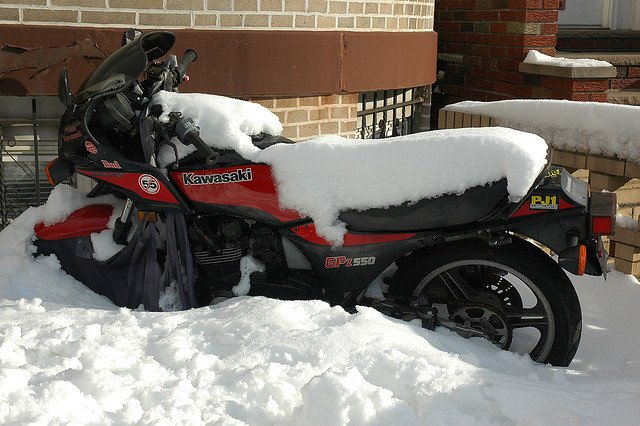Among all the issues that tend to arise over the winter with motorcycles, the easiest to prevent are those caused by road salt. If you put your bike up for the winter and keep it off those cold and unforgiving roads, you won’t have to face this issue, but for those wind blistered die-hards and aspiring die-hards, this is a quick how-to that you should know.
To prevent your bike from dying a salty death is a matter of the simplest maintenance, although it will also be the most frequent maintenance performed in the winter time.
What easier set of required items could there be than a hose, a bucket, a scouring pad, dish soap and a kitchen brush?
Since it’s such a routine maintenance, and it can almost be categorized among other forms of cleaning rather than repair, some people think they can just wash their brakes off with a hose and effectively remove all salt. This isn’t the case, however, because unlike salt that may wash up on other parts of your bike, salt that penetrates the caliper actually changes form during a ride.
Every time you activate the brakes, that salt in your caliper is heated by the rotor passing through, and it solidifies into some kind of chemical gunk that need not be scientifically explained, but must be personally addressed.
The first thing you may notice when you come outside to your bike after having taken it for a winter ride is that the wheel seems stuck or hard to roll. This is almost definitely caused by that expanded salt rubbing as the rotor tries to pass through the caliper.
Fill a bucket with warm water and a few squirts of dish soap, and use a medium to hard bristle household cleaning brush (NOT WIRE) to mix the solution around.
Take a hose and get the worst of the debris out by spraying directly into the caliper and rolling the wheel. Do this on both sides of the caliper where the rotor enters it. Do not use a pressure washer because it can damage other parts of the bike and it is unnecessary.
Then take your brush and continue that process, but without the hose. Just brush below the caliper and roll the wheel so the soapy water moves through it, then brush above the caliper and roll the wheel the other way.
Then wipe the rotor with a scouring pad and roll it through your hand to remove any remaining particles and debris. The final step is actually to repeat the first step and spray with the hose as you roll the wheel several times to let the rotor continuously pass through the caliper.
As another point of interest, if you are purchasing a used bike in the winter months (which is probably the best time to do so), make sure to check over the whole bike for salt damage, particularly with old bikes. If the brakes have been ravaged by winter riding on salty streets, you will have to do some serious replacing, which can run you hundreds of dollars, especially in the case of rotors.
More importantly, though, is the fact that salt damage will not only require you to buy and replace parts, but it is a sign that the owner was very lazy to avoid easy maintenance, and that will almost undoubtedly reflect within the more costly engine and internal parts of the bike down the road.
Photo credit: Dreamstime








